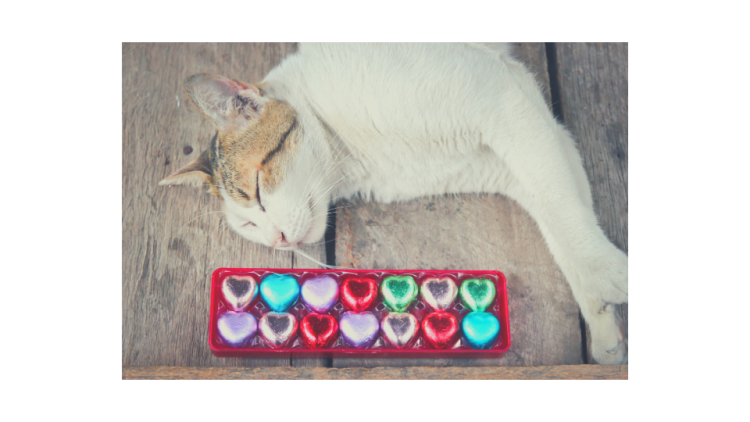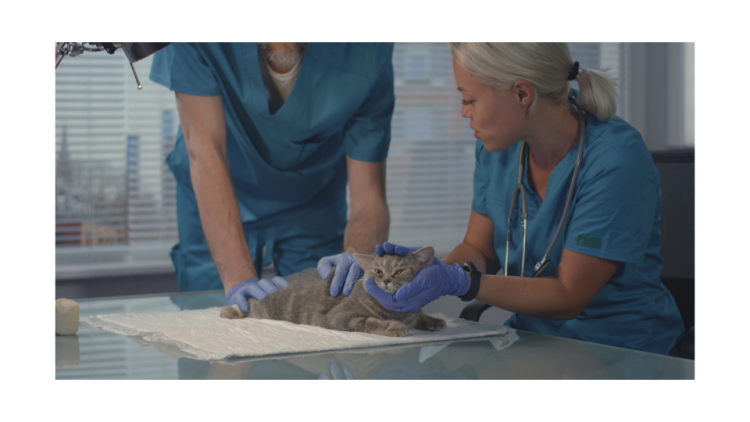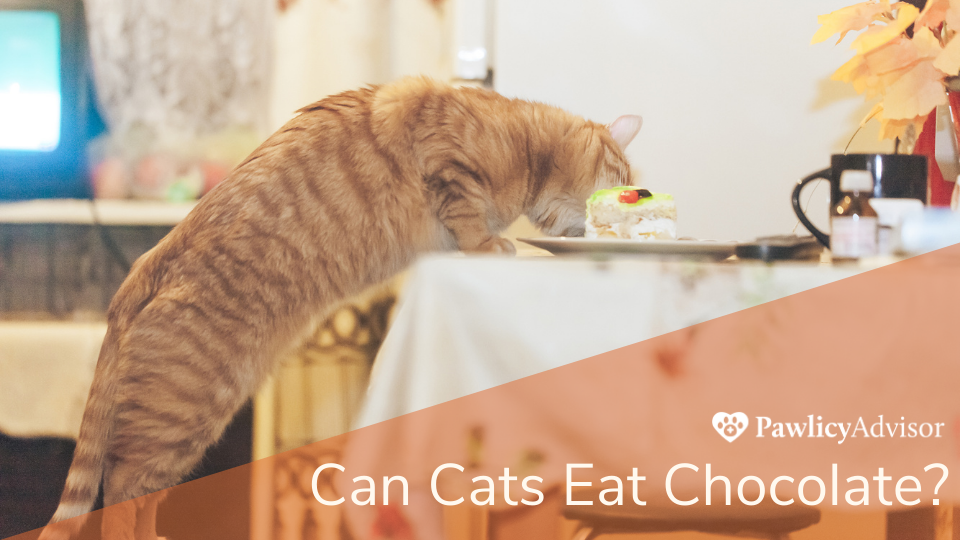Chocolate is toxic to cats. Although it’s more common to hear stories of dogs with stomach upset after digging into sweets, chocolate poses a significant health risk to cats, as well. When cats eat chocolate in large quantities, it can even lead to premature death.
Along with sugar, fat, and xylitol, this sweet compound contains two ingredients that are extremely dangerous to felines: theobromine and caffeine. Pet parents need to be on high alert and keep their goodies well out of reach. Understanding what can happen and how to react if a cat eats chocolate can save your loved one’s life.
Table Of Contents:
- Why is chocolate bad for cats?
- Symptoms of chocolate poisoning in cats
- What to do if your cat eats chocolate
- How to prevent chocolate toxicity in cats
- Can cats eat white chocolate?
- Healthier alternatives than chocolate for cats
- Key Takeaways
Pro Tip: If your pet has ingested chocolate, contact your veterinarian for an emergency appointment. They will conduct urine and blood tests to determine the extent of the poisoning and check the toxicity levels. If your furry friend comes down with food poisoning, having pet insurance will make sure it gets the needed medical treatment without the financial burden.
Why is chocolate bad for cats?
Chocolate contains trace amounts of caffeine and larger portions of theobromine, which are both methylxanthines known to contribute to clinical signs of toxicity within animals. Theobromine is a bitter alkaloid found in the cacao plant and the primary reason why chocolate is bad for cats.
While people can metabolize Theobromine very quickly, felines require much more time for time, resulting in a build-up of byproduct waste that can have very harmful effects on animals. If your cat consumes caffeine alone, the risks are typically less severe, but you’ll probably notice a difference in their hyperactive behavior among other symptoms.
Symptoms of chocolate poisoning in cats
The symptoms of chocolate poisoning in cats usually occur within six to 12 hours of ingestion and can last for up to three to four days in severe cases. If you suspect your cat ate chocolate, the clinical signs of toxic exposure include:
- Diarrhea
- Vomiting
- Increased thirst
- Increased urination
- Accelerated heart rate
- Accelerated breath rate
- Decreased appetite
- Heightened temperature
- Restlessness
- Seizures
- Muscle tremors
- Coma
Cats with chocolate poisoning symptoms can worsen very quickly. Elevated heart rate and sudden rhythm changes can lead to low blood pressure. In addition, muscle spasms and muscle tremors can lead to critically high body temperatures. If left untreated, these changes can prove fatal for your cat.
Pro Tip: The vet expenses of toxic exposure to chocolate are generally not extremely high if the cat arrives within an hour after chocolate ingestion or the degree of exposure is deemed mild. However, if intensive care is required, the expenses to support a feline through such a crisis may add up. This is why we recommend you get a pet insurance plan for your feline friend to help you get the most coverage in case of an accident.

What to do if your cat eats chocolate
If you spot your cat in the act of eating chocolate, take them to your local vet immediately. When caught early enough, the vet can induce vomiting to try and get rid of the toxic element from their system.
Also, it may be that your cat will naturally vomit after eating a piece of chocolate. Whatever the case may be, don't try to induce vomiting at home using remedies such as hydrogen peroxide without a competent veterinarian's advice, as this can cause severe stomach ulcers if used incorrectly
Attempt to find out precisely how much and what kind of chocolate your pet has ingested. When visiting your vet, bring any wrappers or packaging you can find with you, as it will help them identify the level of risk to your pet. Knowing your cat's size and weight will also be helpful when speaking with a veterinarian over the phone, as this is another practical way of assessing your pet's risk.
Try to remain as calm as possible because kittens are known for being very in-tune with their pet owners’ emotions. Keep them relaxed in a quiet place to help the symptoms of chocolate toxicity from escalating.
If you believe that your cat might have consumed chocolate, the best thing you can do is keep a close eye on them so you can be prepared for an emergency vet visit should they get seriously ill. If your cat is usually allowed to spend their day outdoors, keep them inside for a day to ensure that they don’t develop any severe symptoms. Doors and windows should remained closed at all times so your pet stays inside even as you come and go from the house.
When visiting a veterinarian, they will likely conduct a couple of blood and urine tests, including a complete physical exam, They may also perform an ECG to determine if there are any abnormalities in your cat's heart rate.
Once symptoms are exhibited, they must be treated accordingly. In most cases, a veterinarian will administer intravenous fluids and examine for liver disease. If symptoms have worsened, your cat will most likely require hospitalization to eliminate all toxins.

How to prevent chocolate toxicity in cats
As with any other toxic substance in pets, minimizing risk of consumption is always the best and safest practice. Make sure that you keep your chocolate in cat-proof containers or in cabinets that are out of their reach.
Cats are unpredictable, curious creatures who often love to snoop around the kitchen, so try not to leave any baked goods or baking supplies unattended on the counter. Think of all the foods that might contain cocoa: cookies, chocolate bars, brownies, donuts, candies, and store them in a place where your cat can't gain access.
Typically, cats aren’t interested in chocolate, but owners should never offer it willingly as a treat. Owners can safely reward their cat by sticking to safe cat treats that can keep your cat both happy and healthy. Remember, food that contains traces of cocoa can harm your cat, so keep anything with even the tiniest amount of chocolate far away from them.
Can cats eat white chocolate?
No, all types of chocolate are hazardous to cats, including white, dark, milk, semi-sweet, dry cocoa powder, and baking chocolate.
The concentration of theobromine and caffeine is generally proportional to how much cocoa is present. Darker and baking chocolates are the most dangerous to cats, even when consumed in small amounts. Any amount of chocolate can be very harmful to your cat.
However, even white chocolate, with its lower percentage of cocoa, can cause toxicity in cats due to their small size and intolerance of the two harmful compounds. For that reason, chocolate ingestion of any type should be taken seriously, as any cocoa-infused desert may cause poisoning and illness.
Healthier alternatives to chocolate for cats
Even in the unlikeliest event that your cat somehow develops a taste and tolerance for chocolate, you should never offer it as a treat to them. Instead, look for specially formulated treats for cats that will appeal to your feline’s sense and provide a broad range of health benefits. Opt for treats that are not only tasty but also contain nutrients to support your cat’s diet and dental care.
Remember, treating your cat isn’t only about providing delicious food and treats. Giving them love and affection can be just as good as a sweet treat in their eyes.
Key Takeaways
- Cats can’t eat chocolate because cocoa contains caffeine and theobromine. Both ingredients can lead to a toxic build-up, leading to severe symptoms, particularly liver failure.
- At home, make sure that you keep your chocolatey treats and baking ingredients in places that are way out of your cat’s reach.
- If your cat eats chocolate, make sure to call your vet and make an urgent appointment. The vet will likely induce vomiting to rid the toxins from your pet’s system before it damages the liver. A cat pet insurance plan can help ease the financial burden from these unexpected expenses.
